Environmental Impacts of Mechanized Timber Harvesting in Eucalyptus Plantations in Brazil
Abstract
:1. Introduction
2. Materials and Methods
2.1. Description of the Forest Harvesting Site and Process
2.2. Data Collection
2.3. Interactions Networks
2.4. Adaptation of the Environmental Impact Assessment Matrix
- Universality and importance of the criterion;
- Characteristic of the criterion that classifies it for group A or B.
2.4.1. Group A Criteria
2.4.2. Group B Criteria
- Physical environment: parameters related to aspects of climate, soils, relief and hydrology.
- Biotic environment: biological parameters such as flora and fauna.
- Anthropic environment: analysis involving social aspects such as rural workers and the local/regional community, such as occupational health and safety risks, income generation, jobs and changes to the landscape for local residents.
3. Results
3.1. Interaction Networks
3.2. RIAM Matrices
- Road maintenance: improved road quality, less susceptibility to erosion, protection of the soil structure, siltation, erosion, changes in physical properties, damage to conservation areas for flora and fauna, opening of clearings, soil compaction, accidents, health problems, absence or death, regional development, income generation, soil, water and air pollution, waste generation, job creation and regional development.
- Logging: location and disorientation in the local landscape, relationship with the local community, supply of organic matter, damage to conservation areas, opening of clearings, soil compaction, siltation, erosion, accidents, greenhouse effect, health problems, absence or death, regional development, income generation, soil, water and air pollution, waste generation, job creation, regional development.
- Storing and drying wood: location and disorientation, hiding places for dangerous animals, accidents, soil compaction, silting up, health problems, absence or death, job creation and regional development.
- Wood loading: damage to rural roads, soil compaction, siltation, damage to conservation areas (flora and fauna), opening of clearings, greenhouse effect, accidents, health problems, absence or death, regional development, income generation, soil, water and air pollution, waste generation and job creation.
- Road transportation: improvement in road quality, soil compaction, silting, damage to conservation areas, erosion, greenhouse effect, accidents, health problems, absence or death, regional development, income generation, soil, water and air pollution, waste generation, job creation, regional development and depletion of water resources.
4. Discussion
5. Conclusions
Supplementary Materials
Author Contributions
Funding
Acknowledgments
Conflicts of Interest
References
- Schweier, J.; Magagnotti, N.; Labelle, E.R.; Athanassiadis, D. Sustainability impact assessment of forest operations: A review. Curr. For. Rep. 2019, 5, 101–113. [Google Scholar] [CrossRef]
- IBÁ. Indústria Brasileira de Árvores—Relatório Anual 2022. São Paulo. 2021. Available online: https://www.iba.org/ (accessed on 20 February 2024).
- Oliveira, A.B.; Paz, D.A.S.; da Silveira, K.C. Expansão da silvicultura do eucalipto e transformações no uso da terra em municípios do oeste maranhense. InterEspaço Rev. Geogr. E Interdiscip. 2020, 6, e202006. [Google Scholar] [CrossRef]
- Feng, Y.; Audy, J.-F. Silvicultura 4.0: Um framework para a cadeia de suprimentos florestal no contexto da Indústria 4.0. Gestão Produção 2020, 27, e5677. [Google Scholar] [CrossRef]
- Guerino, R.M.G.; de Morais, I.L.; Santos, A.B.d.S.; Campos, R.M. Expansion and socio-environmental impacts of the culture of Eucalyptus spp. (Myrtaceae) in Brazil: A literature panorama. Res. Soc. Dev. 2022, 11, e48811326751. [Google Scholar] [CrossRef]
- Soman, H.; Kizha, A.R.; Roth, B.E. Impacts of silvicultural prescriptions and implementation of best management practices on timber harvesting costs. Int. J. For. Eng. 2019, 30, 14–25. [Google Scholar] [CrossRef]
- Lei Complementar 123/2006. Lei Complementar N° 123, de 14 de Dezembro de 2006. Available online: https://www.planalto.gov.br/ccivil_03/leis/lcp/lcp123.htm (accessed on 11 January 2024).
- Britto, P.C.; Britto, P.C.; Jaeger, D.; Hoffmann, S.; Robert, R.C.G.; Vibrans, A.C.; Fantini, A.C. Impact assessment of timber harvesting operations for enhancing sustainable management in a secondary Atlantic Forest. Sustainability 2019, 11, 6272. [Google Scholar] [CrossRef]
- Alberts, R.C.; Retief, F.P.; Cilliers, D.P.; Roos, C.; Hauptfleisch, M. Environmental impact assessment (EIA) effectiveness in protected areas. Impact Assess. Proj. Apprais. 2021, 39, 290–303. [Google Scholar] [CrossRef]
- Martins, T.S.; Junior, G.N.d.R.C. Avaliação de impacto ambiental: Uma revisão sistemática sob a ótica metodológica. ES Eng. Sci. 2018, 7, 29–41. [Google Scholar] [CrossRef]
- Penadés-Plà, V.; Martínez-Muñoz, D.; García-Segura, T.; Navarro, I.J.; Yepes, V. Environmental and social impact assessment of optimized post-tensioned concrete road bridges. Sustainability 2020, 12, 4265. [Google Scholar] [CrossRef]
- Sánchez, L.E. Avaliação de Impacto Ambiental—Conceitos e Métodos, 3rd ed.; Oficina de Textos: São Paulo, Brasil, 2020; pp. 69–81. [Google Scholar]
- Banyal, S.; Aggarwal, R.K.; Bhardwaj, S.K. A review on methodologies adopted during environmental impact assessment of development projects. J. Pharmacogn. Phytochem. 2019, 8, 2108–2119. [Google Scholar] [CrossRef]
- Harker, K.J.; Arnold, L.; Sutherland, I.J.; Gergel, S.E. Perspectives from landscape ecology can improve environmental impact assessment. Facets 2021, 6, 358–378. [Google Scholar] [CrossRef]
- Ritter, C.D.; McCrate, G.; Nilsson, R.H.; Fearnside, P.M.; Palme, U.; Antonelli, A. Environmental impact assessment in Brazilian Amazonia: Challenges and prospects to assess biodiversity. Biol. Conserv. 2017, 206, 161–168. [Google Scholar] [CrossRef]
- Proto, A.R.; Bacenetti, J.; Macrì, G.; Zimbalatti, G. Roundwood and bioenergy production from forestry: Environmental impact assessment considering different logging systems. J. Clean. Prod. 2017, 165, 1485–1498. [Google Scholar] [CrossRef]
- IBGE. Mapa de Solos do Brasil. Ministério do Planejamento, Orçamento e Gestão, 2001. Available online: https://www.ibge.gov.br/geociencias (accessed on 22 February 2024).
- IBF. Brazilian Forestry Institute. Available online: https://www.ibflorestas.org.br/ (accessed on 5 March 2024).
- Labelle, E.R.; Lemmer, K.J. Selected environmental impacts of forest harvesting operations with varying degree of mechanization. Croat. J. For. Eng. J. Theory Appl. For. Eng. 2019, 40, 239–257. [Google Scholar] [CrossRef]
- Kulmann, M.S.d.S.; Eufrade-Junior, H.d.J.; Dick, G.; Schumacher, M.V.; de Azevedo, G.B.; Azevedo, G.T.d.O.S.; Guerra, S.P.S. Different harvest systems of Eucalyptus clone plantations affect above and belowground biomass production and nutritional sustainability. New For. 2022, 54, 543–563. [Google Scholar] [CrossRef]
- De Jesus, M.S.; Silva, M.G.; Tavares, M.S.; Silva, L.G.O.C.; Santos, R.E.M.; Brandão, T.M.; Costa, I.M.N.B.C.; Amoriom, E.O.C. Métodos de avaliação de impactos ambientais: Uma revisão bibliográfica. Braz. J. Dev. 2021, 7, 38039–38070. [Google Scholar] [CrossRef]
- Pastakia, C.M.R.; Jensen, A. The rapid impact assessment matrix (RIAM) for EIA. Environ. Impact Asses Rev. 1998, 18, 461–482. [Google Scholar] [CrossRef]
- Fonseca, A.; Sánchez, L.E.; Ribeiro JC, J. Reforming EIA systems: A critical review of proposals in Brazil. Environ. Impact Assess. Rev. 2017, 62, n90–n97. [Google Scholar] [CrossRef]
- Duarte, C.G.; Dibo, A.P.A.; Sánchez, L.E. O que diz a pesquisa Acadêmica sobre Avaliação de Impacto e Licenciamento Ambiental no Brasil? Ambiente Soc. 2017, 20, 261–292. [Google Scholar] [CrossRef]
- Nogueira, L.R.S.; Ribeiro, A.I.; Medeiros, G.A.; Martins, A.C.G.; Longo, R.M. Análise integrada dos aspectos e impactos ambientais da atividade operacional em Parque Eólico No Sudoeste Da Bahia/Brasil. Rev. Gestão Sustentabilidade Ambient. 2020, 9, 40–63. [Google Scholar] [CrossRef]
- da Silva, E.B.R.; da Silva, W.C.; Gonçalves, M.F.; Friaes, E.P.P.F.; Pedroso, A.J.S.; da Costa, B.O.; Rocha, C.B.R.; Colares Camargo Júnior, R.N. Principais metodologias de Avaliação de Impacto Ambiental no território brasileiro. CIS-Conjecturas Inter Stud. 2022, 22, 2137–2146. [Google Scholar] [CrossRef]
- Schettino, S.; Azevedo, P.T.O.; Caçador, S.S.; Minette, L.J.; Guimarães, N. Estudo comparativo dos índices de qualidade de vida no trabalho florestal em atividades com e sem mecanização. Agropecuária Científica No Semiárido 2020, 16, 20–26. [Google Scholar] [CrossRef]
- Korneeva, Y.; Simonova, N.; Shadrina, N. The psychosocial risk factors evaluation and management of shift personnel at forest harvesting. Forests 2022, 13, 1447. [Google Scholar] [CrossRef]
- Gümüş, S.; Ünver Okan, S.; Hatay, T. Analysis of work accidents in wood harvesting: A case study of the East Black Sea region. Forestist 2020, 70, 1–7. [Google Scholar] [CrossRef]
- Schettino, S.; Minette, L.J.; Lima, R.C.A.; Nascimento, G.S.P.; Caçador, S.S.; Vieira, M.P.L. Forest harvesting in rural properties: Risks and worsening to the worker’s health under the ergonomics approach. Int. J. Ind. Ergon. 2021, 82, 103087. [Google Scholar] [CrossRef]
- Leite, E.S.; Santos, J.S.; Gomes, B.M.; Nóbrega, J.C.A.; Nóbrega, R.S.A. Compactação do solo causada pelo harvester e intensidade de tráfego do forwarder na colheita florestal. Sci. For. 2020, 48, e3075. [Google Scholar] [CrossRef]
- Pinto, A.C.M.; Souza, A.L.D.; Souza, A.P.D.; Machado, C.C.; Minette, L.J.; Vale, A.B.D. Análise de danos de colheita de madeira em floresta tropical úmida sob regime de manejo florestal sustentado na Amazônia Ocidental. Rev. Árvore 2022, 26, 459–466. [Google Scholar] [CrossRef]
- Picchio, R.; Mederski, P.S.; Tavankar, F. How and how much, do harvesting activities affect forest soil, regeneration and stands? Curr. For. Rep. 2020, 6, 115–128. [Google Scholar] [CrossRef]
- Abbas, D.; Handler, R.M. Life-cycle assessment of forest harvesting and transportation operations in Tennessee. J. Clean. Prod. 2017, 176, 512–520. [Google Scholar] [CrossRef]
- Kouchaki-Penchah, H.; Moaf, A.B.; Kougir-Chegini, Z.; Lang, M.N. Cradle to gate environmental impact assessment of the Iranian forestry operations. Environ. Impact Assess. Rev. 2023, 102, 107183. [Google Scholar] [CrossRef]
- Zhao, J.; Smith, W.; Wang, J.; Zhang, X.; Bergman, R. Life-cycle impact assessment of hardwood forest resources in the eastern United States. Sci. Total Environ. 2024, 909, 168458. [Google Scholar] [CrossRef] [PubMed]
- Toivio, J.; Helmisaaria, H.S.; Palviainena, M.; Lindemanb, H.; Ala-Ilomäkic, J.; Sirénc, M.; Uusitalob, J. Impacts of timber forwarding on physical properties of forest soils in southern Finland. For. Ecol. Manag. 2017, 405, 22–30. [Google Scholar] [CrossRef]
- Rodrigues, C.K.; Lopes, E.d.S.; Müller, M.M.L. Avaliação da qualidade estrutural do solo em colheita mecanizada (harvester e forwarder) de Eucalyptus grandis. Agrarian 2020, 13, 56–62. [Google Scholar] [CrossRef]
- Labelle, E.R.; Hansson, L.; Högbom, L. Strategies to mitigate the effects of soil physical disturbances caused by forest ma-chinery: A comprehensive review. Curr. For. 2022, 8, 20–37. [Google Scholar] [CrossRef]
- Bayle, G. Ecological and social impacts of eucalyptus tree plantation on the environment. J. Biodivers. Conserv. Bioresour. Manag. 2019, 5, 93–104. [Google Scholar] [CrossRef]
- McEwan, A.; Marchi, E.; Spinelli, R.; Brink, M. Past, present and future of industrial plantation forestry and implication on future timber harvesting technology. J. For. Res. 2020, 31, 339–351. [Google Scholar] [CrossRef]
- Titus, B.D.; Brown, K.; Helmisaari, H.S.; Vanguelova, E.; Stupak, I.; Evans, A.; Reece, P. Sustainable Forest biomass: A review of current residue harvesting guidelines. Energy Sustain. Soc. 2021, 11, 1–32. [Google Scholar] [CrossRef]
- de Jesus França, L.C.; Júnior, F.W.A.; e Silva, C.S.J.; Monti, C.A.U.; Ferreira, T.C.; de Oliveira Santana, C.J.; Gomide, L.R. Forest landscape planning and management: A state-of-the-art review. Trees For. People 2022, 8, 100275. [Google Scholar] [CrossRef]
- Savari, M.; Damaneh, E.; Damaneh, E. Factors influencing local people’s participation in sustainable forest management. Arab. J. Geosci. 2020, 13, 513. [Google Scholar] [CrossRef]
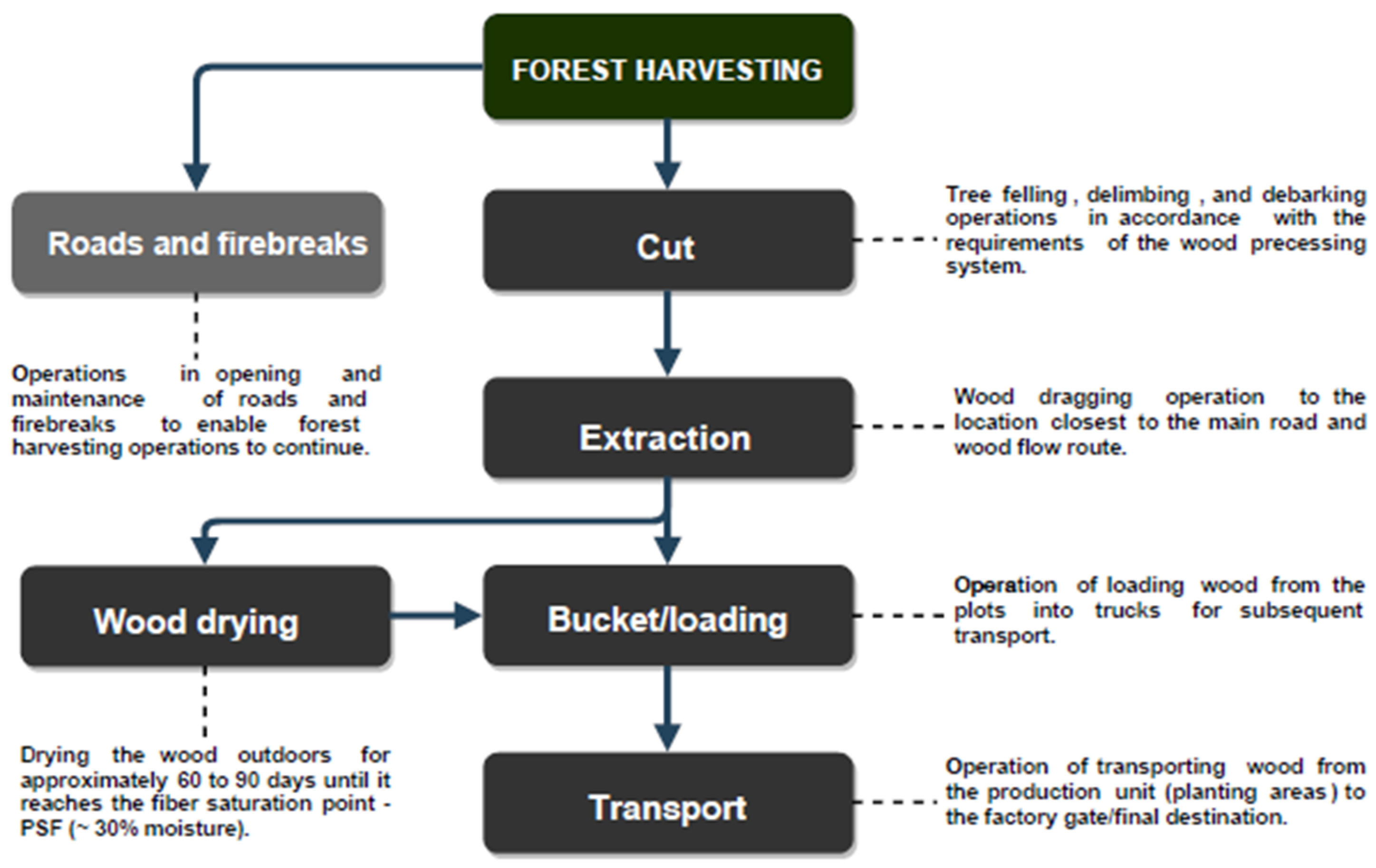
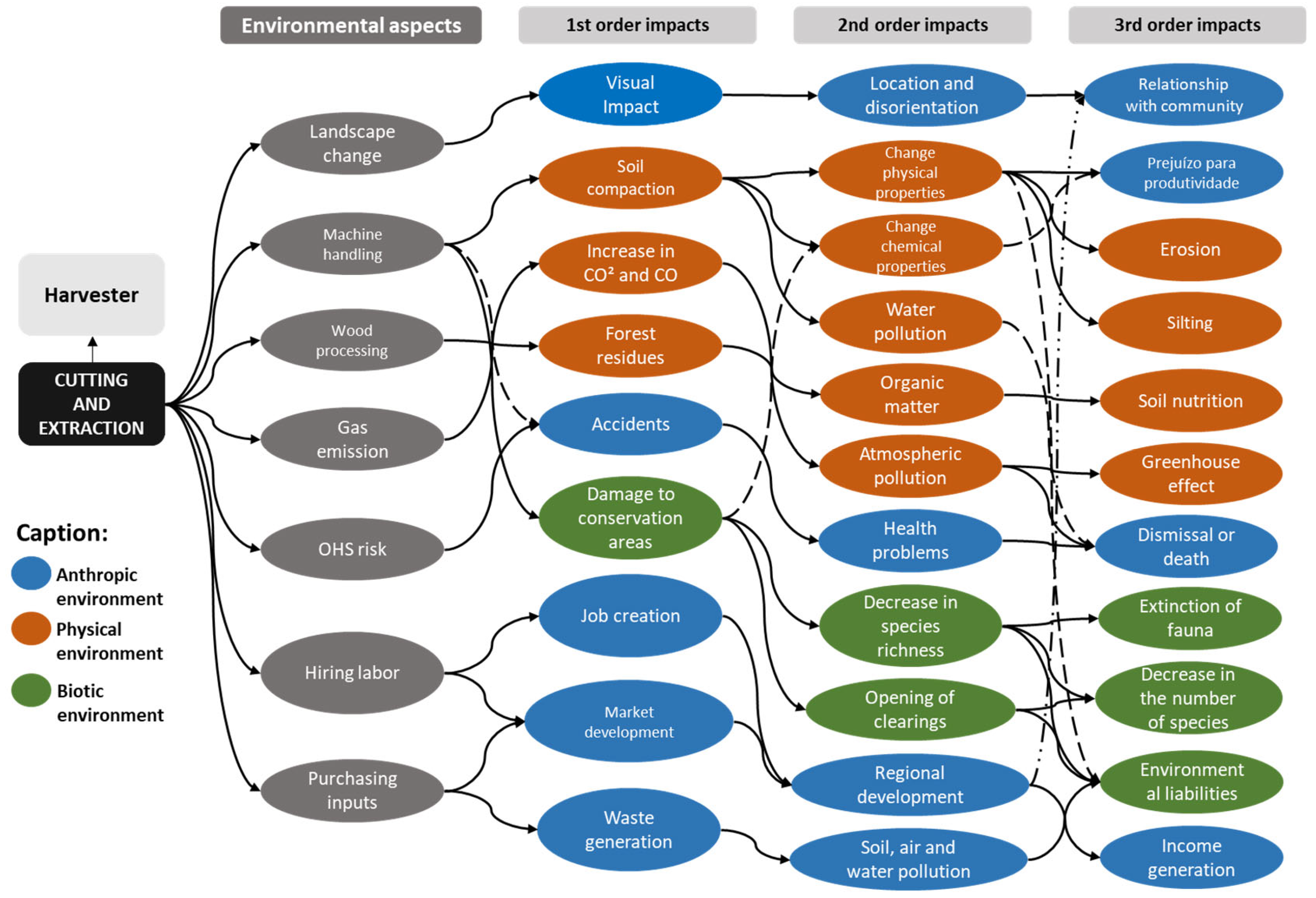
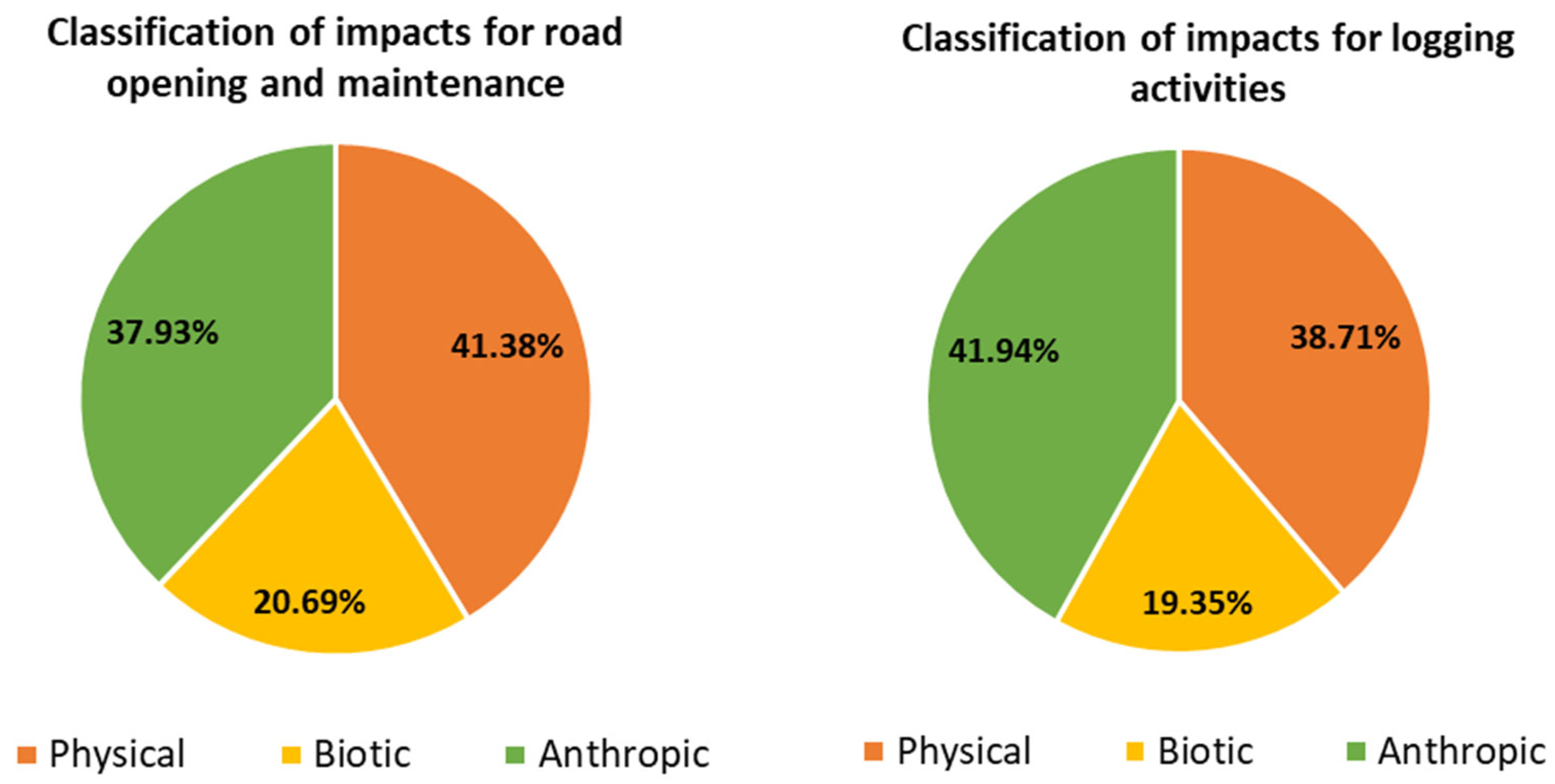
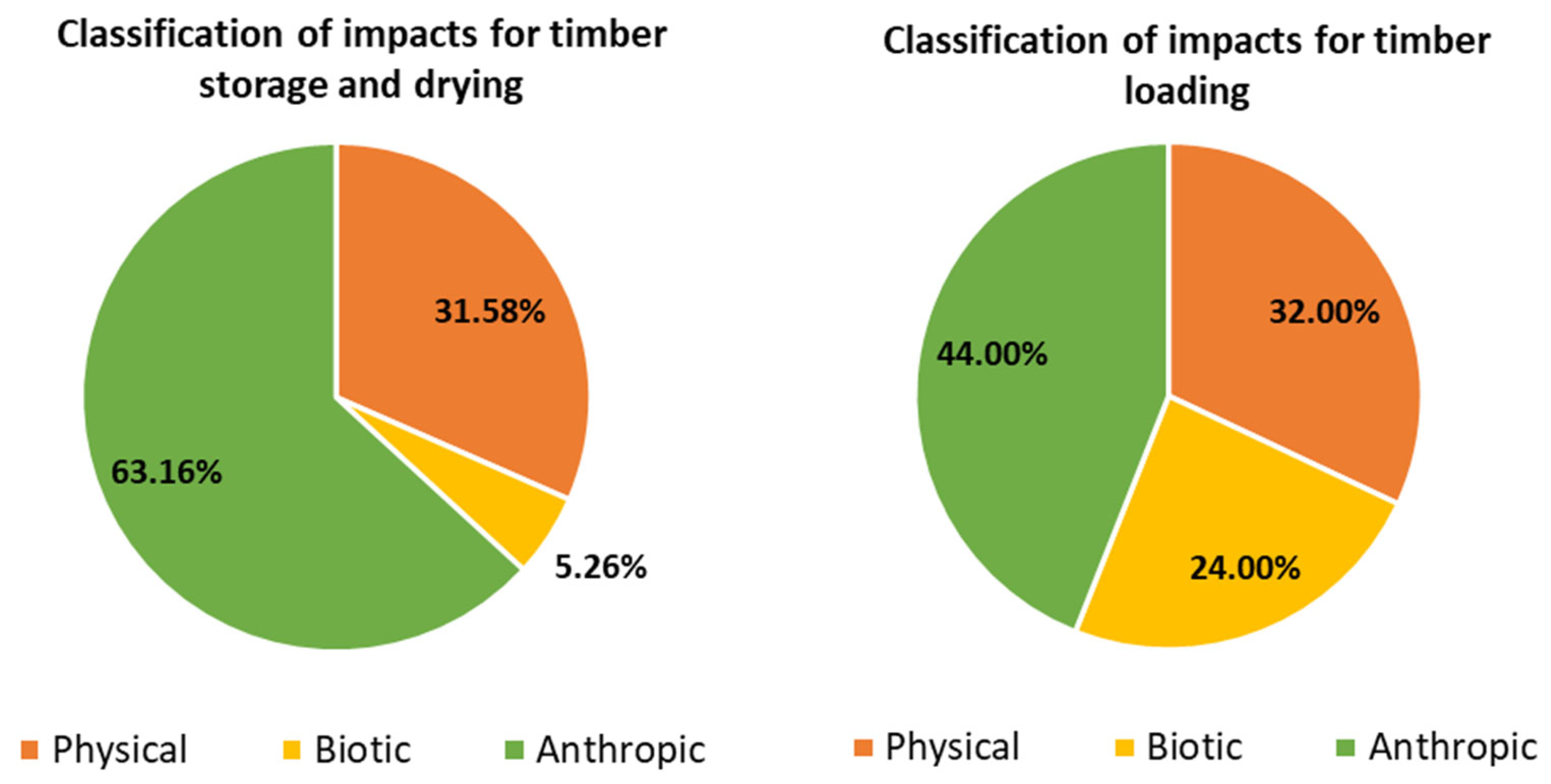

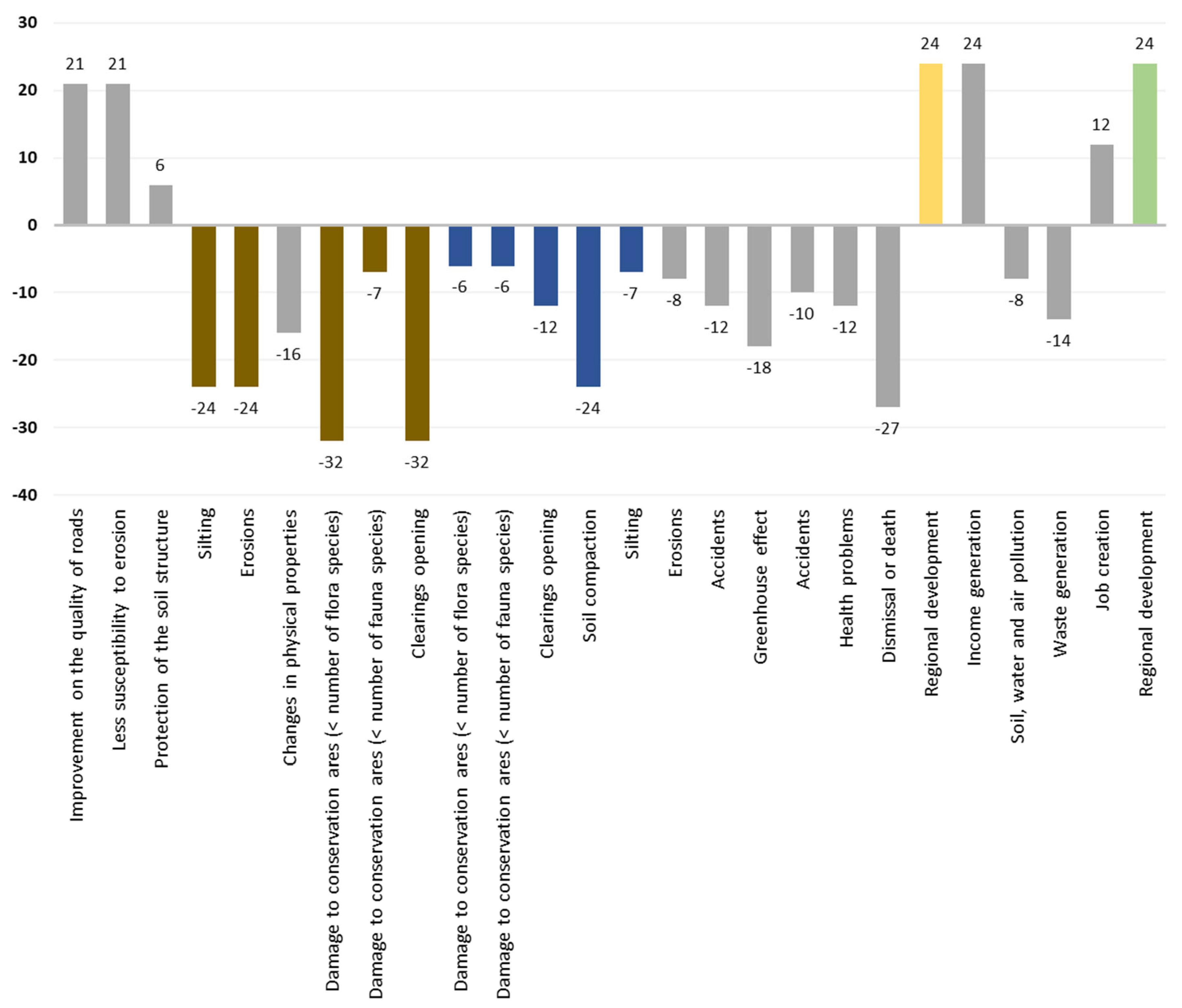
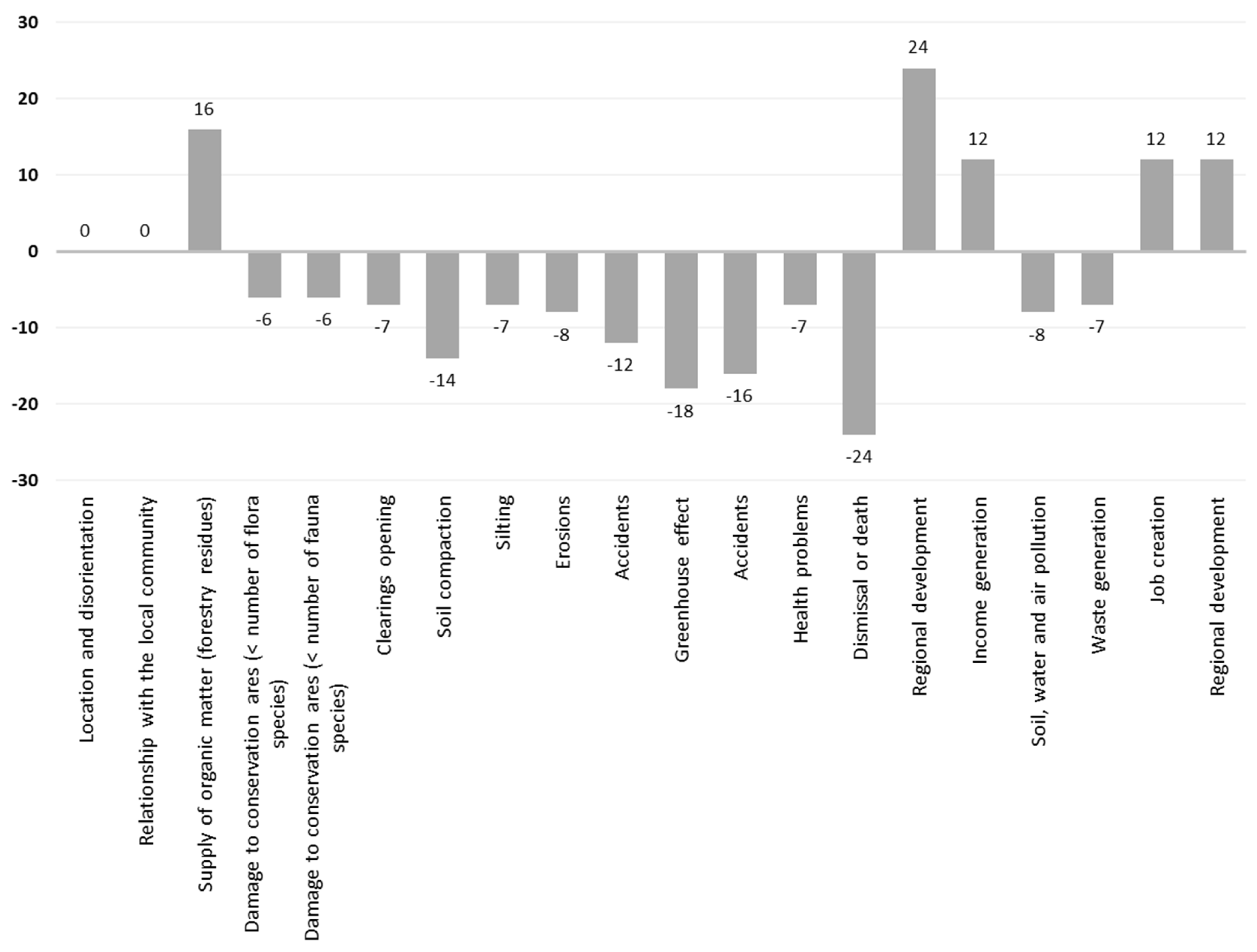

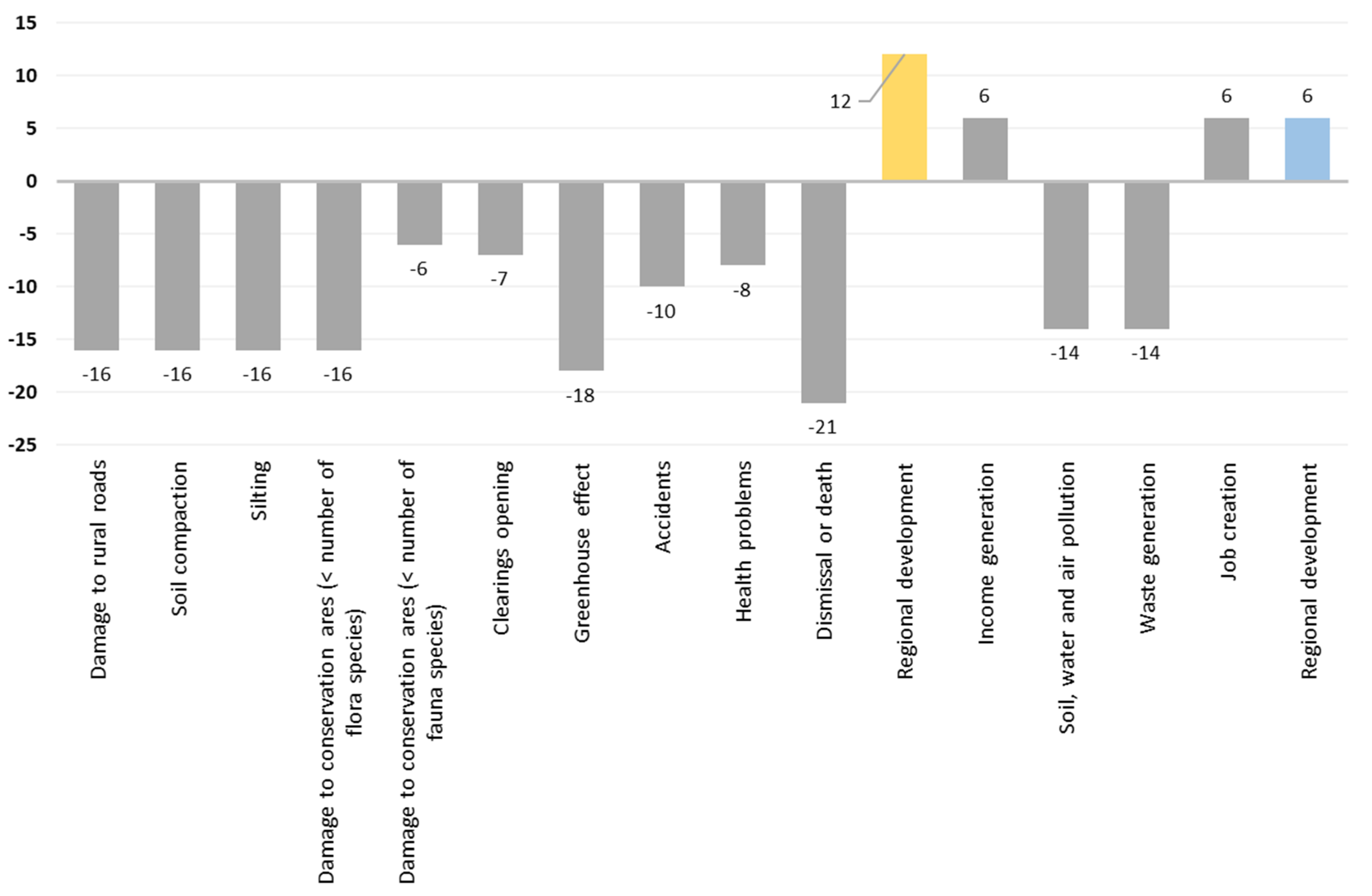
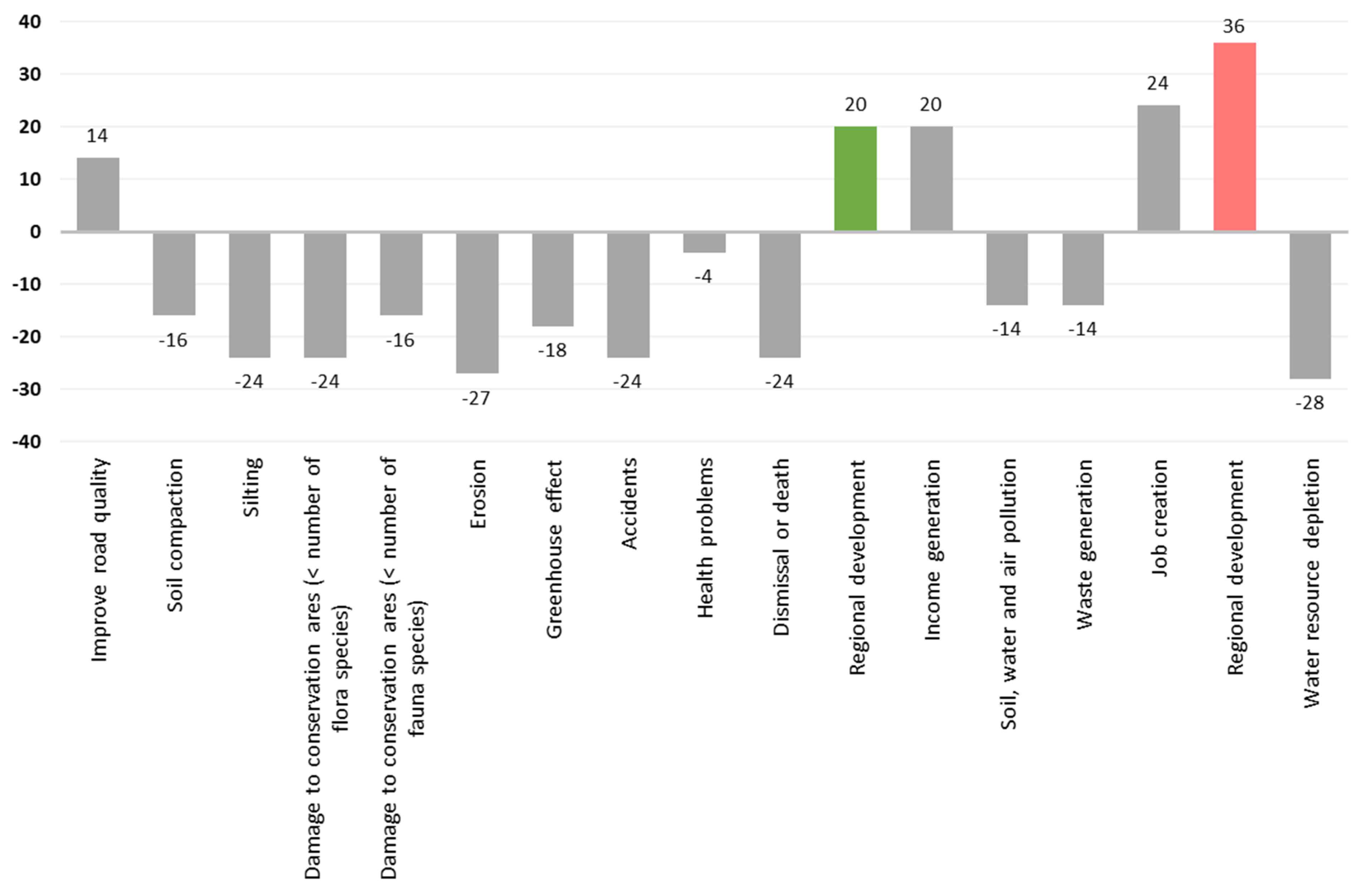
| Value Range (ES) | Numerical Scale | Environmental Impact Class |
|---|---|---|
| 108 to 72 | 5 | Extremely Positive |
| 71 to 36 | 4 | Significantly Positive |
| 35 to 19 | 3 | Moderately Positive |
| 18 to 10 | 2 | Not very positive |
| 09 to 01 | 1 | Very Little Positive |
| Zero | 0 | Unchanged |
| −01 to −09 | −1 | Very Slightly Negative |
| −10 to −18 | −2 | Slightly negative |
| −19 to −35 | −3 | Moderately Negative |
| −36 to −71 | −4 | Significantly Negative |
| −72 to −108 | −5 | Extremely Negative |
| Rapid Impact Assessment Matrix—RIAM | |||||||||||
|---|---|---|---|---|---|---|---|---|---|---|---|
| Activity or Operation | Environmental Aspect | Environmental Impact | Medium | A1 | A2 | B1 | B2 | B3 | Impact Index (ES) | Num. Value (RV) | Environmental Impact Level |
| Wood transportation | Truck traffic | Improved road quality | Anthropic | 1 | 2 | 2 | 2 | 3 | 14 | 2 | Not very positive |
| Soil compaction | Physical | 1 | −2 | 3 | 2 | 3 | −16 | −2 | Slightly negative | ||
| Siltation | Physical | 1 | −3 | 3 | 2 | 3 | −24 | −3 | Moderately Negative | ||
| Damage to conservation areas (>number of flora species) | Biotic | 1 | −3 | 3 | 2 | 3 | −24 | −3 | Moderately Negative | ||
| Activity or Operation | Environmental Aspect | Environmental IMPACT | Guideline for Impact Management |
|---|---|---|---|
| Road opening and maintenance/Wood transportation | Soil extraction for road construction/Truck traffic | Siltation | Carry out a survey of the technologies available for micro-planning forest harvesting operations (be they mathematical models, drones, geoprocessing, etc.), map sites susceptible to erosion (both pre-harvest and post-harvest), carry out a periodic assessment of environmental aspects and impacts, draw up and update field operating procedures, and constantly train rural workers. Create a panel with the environmental aspects and impacts inherent in the operations and keep it visible at support points in the field. |
| Road opening and maintenance/Timber transportation | Soil extraction for road construction/Truck traffic | Erosions | |
| Road opening and maintenance | Machine handling | Soil compaction | |
| Road opening and maintenance/Wood transportation | Soil extraction for road construction/Truck traffic | Damage to conservation areas (>number of flora species) | Map the native vegetation preservation areas directly affected by harvesting operations, carry out the assessment of environmental aspects and impacts periodically, include the care and location of these areas in operating procedures and in the training of field teams. In addition, keep flora inventories of preservation areas up to date, in order to ensure that important species are not suppressed. Create a panel with the environmental aspects and impacts inherent to the operations and keep it visible at the support points in the field. |
| Road opening and maintenance | Soil extraction for road construction | Opening clearings | |
| Road opening and maintenance | OHS risks | Dismissal or death | Train field crews in all harvesting operating procedures. Create a panel with the OHS aspects and impacts inherent in the operations and keep it visible at the support points in the field. |
| Cutting and harvesting/Loading timber | OHS risks | Dismissal or death | |
| Wood transportation | OHS risks | Accidents | |
| Road opening and maintenance | Purchasing inputs | Soil, water and air pollution | Periodically carry out analyses to monitor the quality of water bodies, soil and air, in order to ensure that they are not contaminated or exceed the limits permitted by Brazilian legislation. |
| Wood transportation | Wet roads | Depletion of water resources | Plan the amount of water resources needed to maintain rural roads and monitor/record the amount used in each operation. |
Disclaimer/Publisher’s Note: The statements, opinions and data contained in all publications are solely those of the individual author(s) and contributor(s) and not of MDPI and/or the editor(s). MDPI and/or the editor(s) disclaim responsibility for any injury to people or property resulting from any ideas, methods, instructions or products referred to in the content. |
© 2024 by the authors. Licensee MDPI, Basel, Switzerland. This article is an open access article distributed under the terms and conditions of the Creative Commons Attribution (CC BY) license (https://creativecommons.org/licenses/by/4.0/).
Share and Cite
Ferraz, C.P.A.; Manoel, M.P.d.S.; Chaves, J.V.B.; Aiello, L.H.F.; Silva, G.S.d.; De Medeiros, G.A.; Ribeiro, A.Í. Environmental Impacts of Mechanized Timber Harvesting in Eucalyptus Plantations in Brazil. Forests 2024, 15, 1291. https://doi.org/10.3390/f15081291
Ferraz CPA, Manoel MPdS, Chaves JVB, Aiello LHF, Silva GSd, De Medeiros GA, Ribeiro AÍ. Environmental Impacts of Mechanized Timber Harvesting in Eucalyptus Plantations in Brazil. Forests. 2024; 15(8):1291. https://doi.org/10.3390/f15081291
Chicago/Turabian StyleFerraz, Camila Porfirio Albuquerque, Márcia Pereira da Silva Manoel, Jô Vinícius Barrozo Chaves, Luiz Henrique Freguglia Aiello, Gislene Sales da Silva, Gerson Araújo De Medeiros, and Admilson Írio Ribeiro. 2024. "Environmental Impacts of Mechanized Timber Harvesting in Eucalyptus Plantations in Brazil" Forests 15, no. 8: 1291. https://doi.org/10.3390/f15081291





